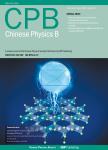Ionospheric vertical total electron content prediction model in low-latitude regions based on long short-term memory neural network
Ionospheric vertical total electron content prediction model in low-latitude regions based on long short-term memory neural network作者机构:Department of Precision InstrumentTsinghua UniversityBeijing 100084China State Key Laboratory of Precision Measurement Technology and InstrumentTsinghua UniversityBeijing 100084China Department of Electronic EngineerTsinghua UniversityBeijing 100084China
出 版 物:《Chinese Physics B》 (中国物理B(英文版))
年 卷 期:2022年第31卷第8期
页 面:347-358页
核心收录:
学科分类:12[管理学] 1201[管理学-管理科学与工程(可授管理学、工学学位)] 070802[理学-空间物理学] 07[理学] 081104[工学-模式识别与智能系统] 08[工学] 0708[理学-地球物理学] 0835[工学-软件工程] 0811[工学-控制科学与工程] 0812[工学-计算机科学与技术(可授工学、理学学位)]
基 金:Project supported by the National Key Research and Development Program of China(Grant No.2016YFA0302101) the Initiative Program of State Key Laboratory of Precision Measurement Technology and Instrument
主 题:long-short-term memory neural network equatorial ionosphere vertical total electron content vertical total electron content(vTEC)
摘 要:Ionosphere delay is one of the main sources of noise affecting global navigation satellite systems, operation of radio detection and ranging systems and very-long-baseline-interferometry. One of the most important and common methods to reduce this phase delay is to establish accurate nowcasting and forecasting ionospheric total electron content models. For forecasting models, compared to mid-to-high latitudes, at low latitudes, an active ionosphere leads to extreme differences between long-term prediction models and the actual state of the ionosphere. To solve the problem of low accuracy for long-term prediction models at low latitudes, this article provides a low-latitude, long-term ionospheric prediction model based on a multi-input-multi-output, long-short-term memory neural network. To verify the feasibility of the model, we first made predictions of the vertical total electron content data 24 and 48 hours in advance for each day of July 2020 and then compared both the predictions corresponding to a given day, for all days. Furthermore, in the model modification part, we selected historical data from June 2020 for the validation set, determined a large offset from the results that were predicted to be active, and used the ratio of the mean absolute error of the detected results to that of the predicted results as a correction coefficient to modify our multi-input-multi-output long short-term memory model. The average root mean square error of the 24-hour-advance predictions of our modified model was 4.4 TECU, which was lower and better than5.1 TECU of the multi-input-multi-output, long short-term memory model and 5.9 TECU of the IRI-2016 model.



